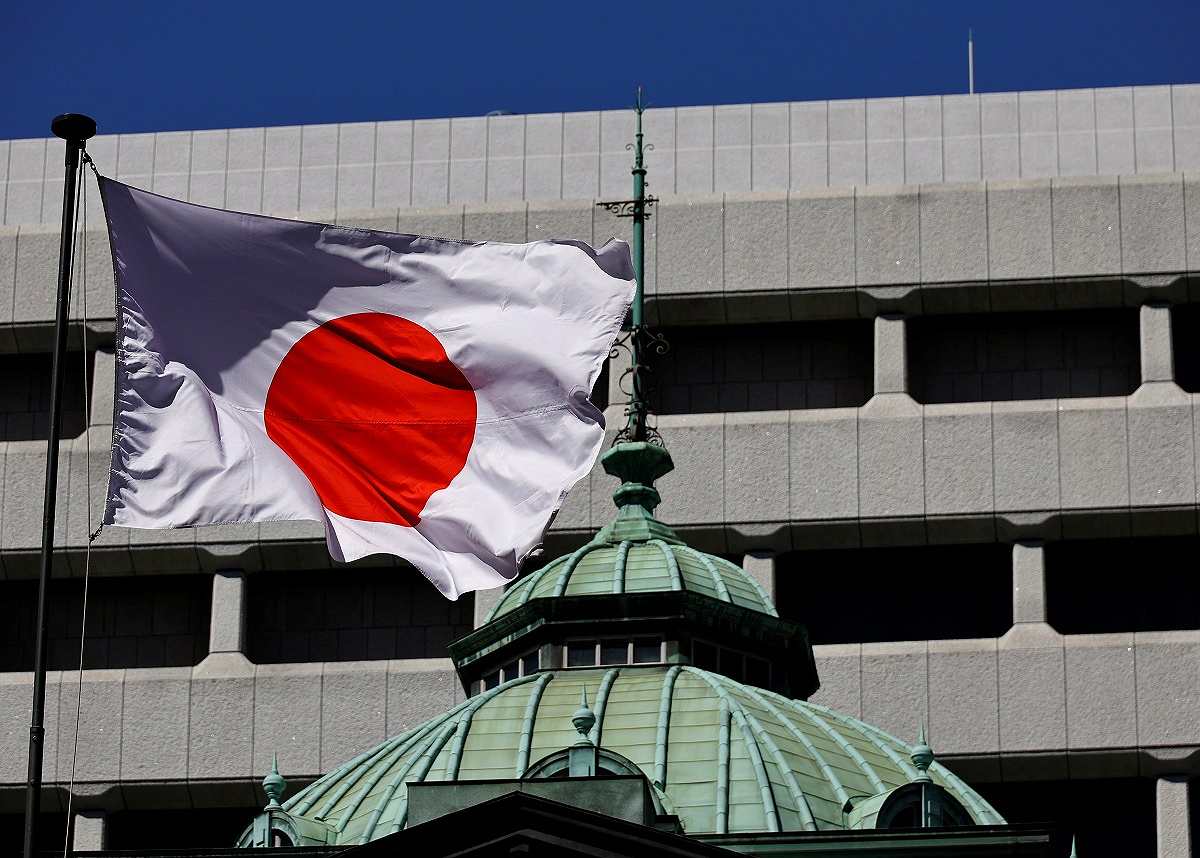
Japan’s national flag flutters atop the Bank of Japan (BOJ) building in Tokyo.
11:24 JST, October 30, 2024
TOKYO (Reuters) – The Bank of Japan concludes a two-day policy meeting on Thursday, days after the ruling coalition’s loss in a weekend election that has heightened political uncertainty and complicates efforts to roll back monetary stimulus.
Here is a guide on what to expect and why the BOJ’s rate review matters:
IS BOJ GOING TO RAISE INTEREST RATES?
The BOJ ended negative interest rates in March and raised its short-term policy target to 0.25% in July. It has signaled readiness to hike again, once the board has enough confidence that Japan will durably hit its 2% inflation target.
With inflation stable around 2% and showing few signs of spiking, however, the BOJ is in no rush to pull the trigger.
The central bank is widely expected to keep rates steady at the October meeting, as Governor Kazuo Ueda has stressed the need to spend time scrutinizing risks such as uncertainty over the U.S. economy and the fallout from volatile markets.
The BOJ will also prefer to stand pat until the make-up of Japan’s future government – now in flux – becomes clearer.
WHAT SHOULD MARKETS LOOK OUT FOR?
The BOJ has said it will hike rates again if the economy and prices move in line with its forecast. That means its quarterly report, which will include the board’s fresh growth and price forecasts, may offer clues on the next rate hike timing.
Sources have told Reuters the BOJ is unlikely to make major changes to its forecast for inflation to hover around its 2% target through March 2027.
While such projections would meet the prerequisite for more rate hikes, the BOJ may signal its readiness to go slow by highlighting risks such as slow global growth and the damage volatile markets could inflict on household and corporate mood.
If the BOJ reiterates its warning over such risks or refers to them in the report’s portion on policy guidance, that could further diminish the chance of a year-end rate hike. Increased optimism over sustained wage hikes, by contrast, could be a sign the next rate hike is nearing.
WHAT ELSE SHOULD MARKETS LOOK OUT FOR?
Governor Ueda’s post-meeting briefing, to be held at 3:30 p.m. Tokyo time (0630GMT) on Thursday, may offer clues on the pace and timing of further rate hikes.
In a briefing in September, Ueda dropped signs of a pause by saying the BOJ can “afford” to spend time scrutinizing risks such as uncertainty over the U.S. economic outlook.
Ueda may replace such dovish communication with something more neutral due to receding fears of U.S. recession – and the need to keep speculators from pushing down the yen too much.
The dollar hit three-months highs near ¥153.50 on Tuesday, as investors sold the Japanese currency on the view the post-election political uncertainty will discourage the BOJ from hiking rates any time soon.
While still off the three-decade low near 161 to the dollar, the yen’s recent declines could trigger renewed warnings from Ueda on the upward pressure such moves would have on import costs and inflation.
WHAT DO ANALYSTS THINK ABOUT NEXT RATE HIKE TIMING?
After the October meeting, the BOJ next meets for a policy meeting on Dec. 18-19 followed by a meeting on Jan. 23-24.
A slim majority of economists polled by Reuters saw the BOJ forgoing a hike this year, with most expecting the central bank to raise rates again by March next year.
WHAT COULD HAMPER FURTHER RATE HIKES?
The BOJ has signaled readiness to raise rates to levels deemed neutral to the economy – seen by analysts as somewhere around 1% – by around late next year or early 2026.
The International Monetary Fund (IMF) also called on the BOJ to tighten policy at a gradual pace and projected policy rates to reach 1.5% in 2027.
But the road could be bumpy. The BOJ hopes bumper wage hikes offered by firms this year will underpin consumption, and allow retailers to keep hiking prices. But slowing global demand may discourage manufacturers from offering big pay hikes next year.
Political clouds also hang over the BOJ’s rate-hike path.
The ruling coalition’s failure to retain a majority in the lower house will likely force Prime Minister Shigeru Ishiba’s ruling party to court smaller opposition parties that favor maintaining ultra-loose monetary policy.
While Ishiba has been seen as supportive of gradual policy normalization, his weakened standing may raise the hurdle for further BOJ rate hikes.
Market moves may also sway the rate hike timing, including the fallout from the outcome of the U.S. presidential election.
"News Services" POPULAR ARTICLE
-

American Playwright Jeremy O. Harris Arrested in Japan on Alleged Drug Smuggling
-

Japan’s Nikkei Stock Average as JGB Yields, Yen Rise on Rate-Hike Bets
-

Japan’s Nikkei Stock Average Licks Wounds after Selloff Sparked by BOJ Hike Bets (UPDATE 1)
-

Japan’s Nikkei Stock Average Buoyed by Stable Yen; SoftBank’s Slide Caps Gains (UPDATE 1)
-

Japanese Bond Yields Zoom, Stocks Slide as Rate Hike Looms
JN ACCESS RANKING
-

Tokyo Economic Security Forum to Hold Inaugural Meeting Amid Tense Global Environment
-

Keidanren Chairman Yoshinobu Tsutsui Visits Kashiwazaki-Kariwa Nuclear Power Plant; Inspects New Emergency Safety System
-

Imports of Rare Earths from China Facing Delays, May Be Caused by Deterioration of Japan-China Relations
-

University of Tokyo Professor Discusses Japanese Economic Security in Interview Ahead of Forum
-

Japan Pulls out of Vietnam Nuclear Project, Complicating Hanoi’s Power Plans

























